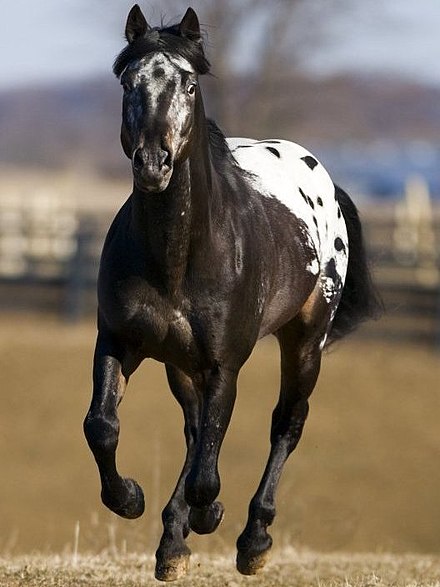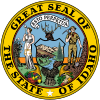List of Idaho state symbols

The state of Idaho has 16 official emblems, as designated by the state legislature. These symbols, which reflect the history and culture of the state, are often opportunities for politicians to "tie themselves to popular symbols", for teachers to highlight the legislative process to their students, and for lobbyists to "have their products given official designation".[1]
Idaho's first official symbol was its seal, adopted in 1863 when the Idaho Territory became an organized incorporated territory of the United States. The state's second symbol was its motto, which was chosen shortly after Idaho was admitted to the Union in 1890. Five additional symbols were added between 1900 and 1950, including three in 1931 alone. Six symbols were designated between 1950 and 2000, and three additional symbols have been added since 2000. Two symbols have been adopted that were proposed by students; the Appaloosa became the state horse in 1992 following a proposal from sixth-graders from Eagle, Idaho, and in 1992 elementary school students in Boise introduced the monarch butterfly as the state insect. Idaho's most recent symbol is the Idaho giant salamander, adopted as the state amphibian in 2015.
While some of the symbols are unique to Idaho, others are used by multiple states. For example, the mountain bluebird, Idaho's state bird, is also an official symbol for Nevada.[2] Idaho's state fish, cutthroat trout, is also an official symbol for Wyoming,[3] while specific subspecies of cutthroat are the state fish of Colorado, Montana, Nevada, New Mexico, and Utah.[4][5][6][7][8] The square dance and monarch are commonly used state dances and state insects (or in some cases state butterflies), respectively.
State symbols
| Type | Symbol | Description | Adopted | Image |
|---|---|---|---|---|
| Amphibian | Idaho giant salamander | The Idaho giant salamander (Dicamptodon aterrimus) is the largest salamander found in the state of Idaho, where it lives almost exclusively. Over their lifetime, these salamanders will metamorphose from a larva to a terrestrial adult, or will mature into an adult but retain the larval form, such as keeping gills, growing to lengths of 33 cm (~13 in). Idaho giant salamanders are generally found in moist coniferous forests and can change colors. The transformed adults are secretive and seldom found in the open, but can be found in moist areas.[9] | 2015 | |
| Bird | Mountain bluebird (Sialia currucoides)[10] |
Adopted as the state bird by the Idaho Legislature in 1931, the mountain bluebird is one of two bluebird species found in the state. Known for their bright blue plumage, these migratory birds often arrive in Idaho in late February or early March, nest, then migrate south in September or early October.[11] | 1931 | 
|
| Dance | Square dance | 1989 | 
| |
| Fish | Cutthroat trout (Oncorhynchus clarkii) |
Native to Idaho, the cutthroat trout's name comes from the "distinctive red to orange slash" on the underside of its jaw. During an attempt to designate a state fish in 1988, critics of the cutthroat pointed out that the species was not found throughout the entire state. When the Legislature adopted the species in 1990, bill sponsor Mary Lou Reed called the cutthroat a "good symbol" of the state's "quality of life".[12] | 1990 | |
| Flag | Flag of Idaho | 1957 | 
| |
| Flower | Syringa (Philadelphus lewisii) |
Documented and collected by Meriwether Lewis in 1806, the syringa was designated the Idaho State Flower in 1931.[citation needed] | 1931 | 
|
| Fossil | Hagerman horse (Equus simplicidens) |
The Hagerman horse (Equus simplicidens originally described as Plesippus shoshonensis) was declared the official state fossil of Idaho by the 1988 Legislature. A 3.5 million year old fossil bed near Hagerman, discovered in the 1920s, has yielded more than 30 complete horse skeletons and is said to be the "best known Pleistocene-epoch fossil site in the world".[13] Hagerman Fossil Beds National Monument, specifically the Hagerman Horse Quarry,[14] contains the largest concentration of these fossils.[13] | 1988 | 
|
| Fruit | Huckleberry | Several huckleberry species are native to Idaho (all belonging to genus Vaccinium), the most popular of which are black or thin-leaved huckleberry (Vaccinium membranaceum). The berries are difficult to grow commercially, as they can take up to 15 years to reach maturity, grow at specific elevations, and attempts to transplant often end in failure.[15][16] However, attempts are underway to domesticate the berry. Students from Southside Elementary School proposed the huckleberry as the state fruit in 2000.[17] | 2000 | 
|
| Gem | Star garnet | Star garnet, found only in Idaho and India, was designated as the state gem in 1967.[18][19] | 1967 | 
|
| Horse | Appaloosa | The Appaloosa breed became the state horse in 1975 following an introduction to the Legislature by sixth grade students from Eagle, Idaho.[17] | 1975 | 
|
| Insect | Monarch butterfly (Danaus plexippus) |
The monarch became designated as the state insect after a bill proposed by fourth grade students at Cole Elementary in Boise was passed unanimously by State Senators.[20] | 1992 | 
|
| Motto | Esto perpetua | Translating to "Let it be perpetual" or "It shall be perpetual", Idaho's official motto was designated soon after the state was admitted to the Union in 1890. The phrase Esto perpetua is attributed to the Venetian theologian Pietro Sarpi.[21] The motto appears on the state's seal and on its quarter as part of the 50 State Quarters program, which lasted 1999–2008. | 1890 | |
| Raptor | Peregrine falcon (Falco peregrinus) |
Adopted as the state raptor by the Legislature in 2004, the peregrine falcon has a global distribution and can be found on each continent apart from Antarctica. Boise is home to the World Center for Birds of Prey, the headquarters for The Peregrine Fund, a non-profit organization founded in 1970 that conserves threatened and endangered birds of prey.[22] The peregrine falcon appears on the Idaho state quarter. | 2004 | 
|
| Seal | Seal of Idaho | The Idaho Territory seal was adopted in 1863 and redrawn several times before statehood in 1890. The Great Seal was designed by Emma Edwards Green, the only woman to design a state seal. The seal depicts a woman, signifying justice, and a miner along with cornucopias, a pine tree, sheaf of grain, syringa, an elk's head, wheat and other imagery associated with the state. | 1863 | 
|
| Song | "Here We Have Idaho" | Music for the state song of Idaho was composed by Sallie Hume Douglas and copyrighted on November 4, 1915 under the name "Garden of Paradise". In 1917, University of Idaho student McKinley Helm wrote the verse which became the chorus, and Alice Bessee set the words to Douglas' music. The song, then known as "Our Idaho", became the university's alma mater. Albert J. Tompkins, director of music in the Boise Public Schools, wrote additional verses for the song, and in 1931 the Legislature designated "Here We Have Idaho" as the state song. | 1931 | — |
| Tree | Western white pine (Pinus monticola) |
Adopted as a state symbol by the Legislature in 1935, western white pine is known for its "straight grain and soft even texture".[15] In the United States, the largest remaining volume of this timber grows in Northern Idaho. | 1935 | 
|
| Vegetable | Potato | The nation's leader in production, Idaho has become synonymous with potatoes[23] Fourth grade students from Grand View Elementary school led the effort for the symbol in 2002, writing to all 105 lawmakers pushing for the bill.[24] | 2002 | 
|
Unsuccessful proposals
Several symbols have been proposed for addition to the list of official state symbols but were not adopted. Prior to the designation of the cutthroat trout as the state fish, fourth grade students at Indian Creek Elementary School campaigned for the rainbow trout and the sturgeon.[25] Another unsuccessful symbol included the silver tipped sagebrush as the state bush.[26] In the 2010s, a student proposal for the rattlesnake as the state reptile was unsuccessful since farmer-legislators considered the snake a "pest".[17]
See also
References
- General
- "Idaho State Symbols". Office of the Governor. 2007. Retrieved January 22, 2010.
- Specific
- ^ James, Michael S. (December 27, 2004). "State Pride, Via Soil, Milk, Popcorn, Pork". ABC News. Retrieved January 24, 2010.
- ^ "Mountain Bluebird". Nevada Department of Wildlife. Retrieved May 23, 2011.
- ^ "State Symbols". Wyoming Secretary of State. Archived from the original on September 6, 2011. Retrieved January 22, 2010.
- ^ "Colorado State Archives - Symbols & Emblems". Colorado Department of Personnel and Administration. Retrieved January 22, 2010.
- ^ "Symbols of Montana". Montana Historical Society. Archived from the original on August 28, 2010. Retrieved January 22, 2010.
- ^ "State Symbols". Nevada Department of Wildlife. Archived from the original on April 8, 2003. Retrieved May 23, 2011.
- ^ "State Symbols". New Mexico Secretary of State. Archived from the original on May 1, 2008. Retrieved January 22, 2010.
- ^ "Utah State Symbols". State of Utah. Retrieved January 22, 2010.
- ^ "Idaho State Emblems". www.sos.idaho.gov. Archived from the original on 2016-07-20. Retrieved 2016-02-17.
- ^ "Sialia currucoides". United States Forest Service. Retrieved January 23, 2010.
- ^ "Homes for Idaho's Bluebirds". United States Forest Service. 2008. Retrieved January 23, 2010.
- ^ "Idaho Senate wants cutthroat as state fish". Moscow-Pullman Daily News. TPC Publishing. March 12, 1990. Retrieved January 22, 2010.
- ^ a b "Hagerman Fossil Beds". National Park Service. Retrieved January 23, 2010.
- ^ Richmond, Dean R.; McDonald, H. Gregory. "The Hagerman Horse Quarry: Death and Deposition". National Park Service. Retrieved January 23, 2010.
- ^ a b "Idaho State Symbols". Office of the Governor. 2007. Archived from the original on June 30, 2010. Retrieved January 22, 2010.
- ^ Russell, Betsy Z. (July 7, 2005). "Wild huckleberry nearly tamed". The Spokesman-Review. Cowles Publishing Company. Retrieved January 29, 2010.
- ^ a b c "Huckleberry: Students ready to lobby for fruit". The Spokesman-Review. Vol. 117, no. 250. February 15, 2000. p. A5. Retrieved May 21, 2011.
- ^ White, Vera (April 4, 1989). "'Garnet Queen' catches stars". Moscow-Pullman Daily News. Vol. 9, no. 80. Pullman, Washington. p. 1B. Retrieved May 21, 2011.
- ^ "Cities, Counties, Schools Get Financial Reassurance". The Spokesman-Review. Vol. 84, no. 273. February 11, 1967. p. 24. Retrieved May 21, 2011. Note: See "In Session Briefly" section.
- ^ "Democracy for monarchs". The Register-Guard. Guard Publishing. March 20, 1992. Retrieved January 24, 2010.
- ^ "Idaho's State Motto" (PDF). Idaho State Historical Society. March 1970. Retrieved January 22, 2010.
- ^ "The Peregrine Fund - Mission". The Peregrine Fund. Retrieved January 29, 2010.
- ^ "It's official: Potato is Idaho's vegetable". Park City Daily News. News Publishing LLC. March 2, 2002. Retrieved January 24, 2010.
- ^ Russell, Betsey Z. (February 8, 2002). "Potato: Kids wrote to every lawmaker". The Spokesman-Review. Vol. 119, no. 243. p. B1, B2. Retrieved May 21, 2011.
- ^ "Students: Sturgeon should be state fish". Moscow-Pullman Daily News. TPC Publishing. January 25, 1988. Retrieved January 22, 2010.
- ^ "Symbols under consideration include pies and insects". The Telegraph. Telegraph Publishing Company. June 2, 1988. Retrieved January 24, 2010.